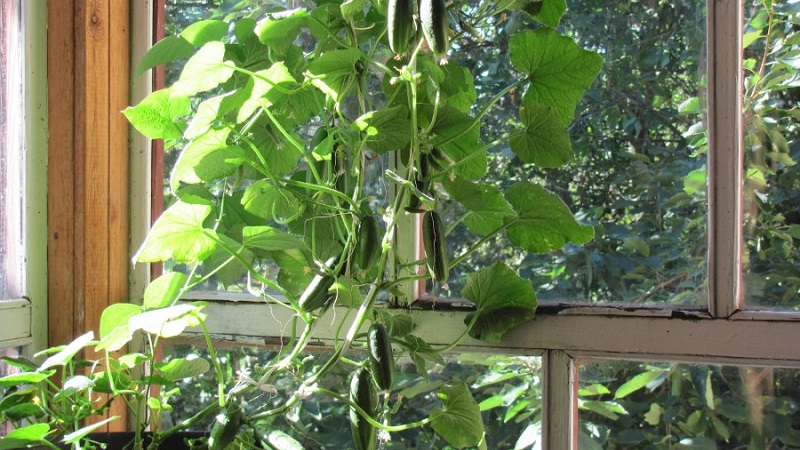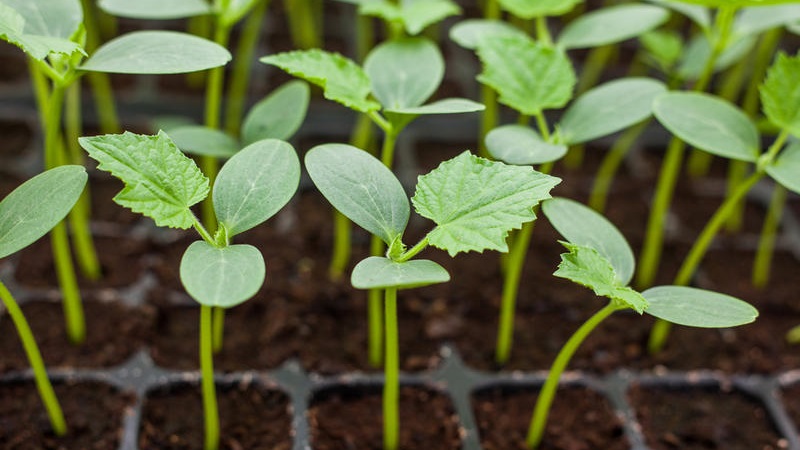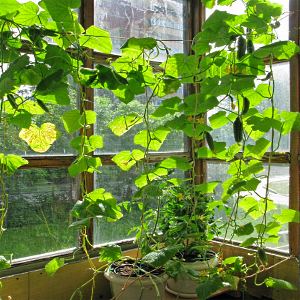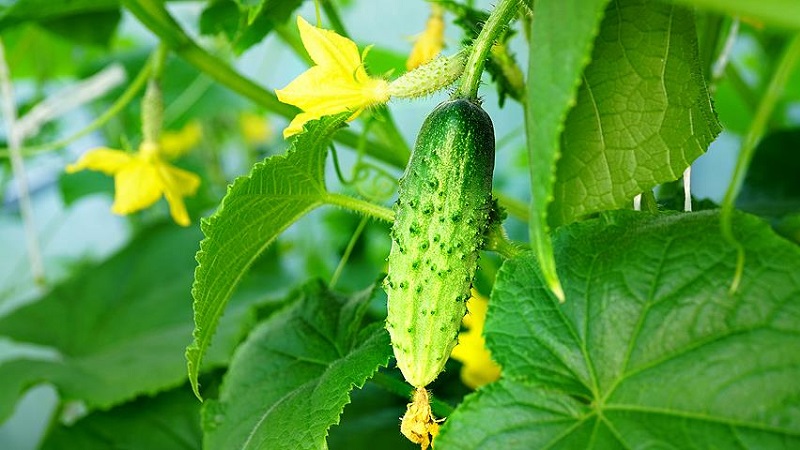Step-by-step instructions for novice vegetable growers: how to grow cucumbers on the balcony and get a harvest
If you do not have a summer cottage, you can always use the balcony to grow your favorite vegetables. Cultivating cucumbers at home is a great option for those who want to harvest healthy fruits in winter. All that is needed for this is to properly prepare the room and choose the varieties of plants that are most suitable for balcony beds.
The content of the article
What varieties of cucumbers can be grown at home
To grow a good harvest on a balcony or windowsill without additives and nitrates, many delicious varieties of cucumbers are suitable, but the choice of seeds should be approached responsibly. The best option is hybrid varieties that can withstand temperature changes.
The package also indicates a list of the characteristics of the culture:
- root development;
- ripening period;
- the need for lighting;
- fruit and leaf size;
- drought resistance;
- number of ovaries;
- pollination.
The best option for growing on the balcony is hybrid gherkins. One of the advantages of such varieties is their limited length: the vegetable will not outgrow, even if it is not picked in time. The variety begins to bear fruit very quickly. A few cucumber bushes, planted at 2-4 weeks intervals, will give you crops all year round.
For your information. For growing cucumbers in indoor conditions, a hydroponic cultivar is actively used.
Given the limited space and microclimate for growing cucumbers, the following varieties are the best choice:
- Debut;
- Misha;
- Stella;
- Zozulya;
- Courage;
- Barnaulets;
- Stresa;
- April;
- Dubrovsky;
- Turquoise;
- Sail;
- Matrix;
- Balcony miracle.
Hybrids of different ripening times will also be a good choice:
- Marinda F1;
- Claudia F1;
- Cucaracha;
- Hercules;
- Bianca;
- Gladiator.
Be careful! When choosing, it is important to remember that varieties have different shapes and colors, and some species have a specific bitterness.

What do you need
When the seed is prepared, you should pick up a container for planting, prepare the soil and fertilizer. The creation of the necessary microclimate is one of the main conditions for obtaining a full-fledged harvest of cucumbers on the balcony.
About the best varieties of yellow tomatoes for a greenhouse, you can read here.
What to grow
Various boxes, pots or flowerpots can be used as a container for growing crops. The larger the vessel, the better for the plant. A larger container holds more soil, and, accordingly, moisture will retain longer. But you must not allow excess moisture - this is harmful to the roots. To avoid waterlogging, you should take care of reliable drainage.
It is advisable to use containers that retain heat well, for example, black plastic boxes or pots. It is convenient to grow cucumbers on the balcony in hanging pots, trimmed five-liter bottles or pots.
On a note. If another plant has previously grown in the container, then it should be thoroughly cleaned before use. In old containers, pathogenic bacteria from past seedlings can remain that can harm the culture.

Required materials and tools
To grow cucumbers, you will need the following tools and materials:
- seed material;
- manganese for disinfection;
- saucer;
- cotton fabric;
- drug to stimulate growth;
- container for planting;
- priming;
- fertilizers;
- water for irrigation;
- polyethylene film;
- climate control system;
- phytolamps (if necessary);
- a set of tools for indoor plants;
- supports and threads for tying.
Site requirements
The best place to grow vegetables is considered to be window sills located on the south or southeast side of the house. In this case, the culture will receive the required amount of solar heat and light.
On a note. Experienced vegetable growers install a climate control system when growing cucumbers on the balcony. If this is not done, then the first young shoots may die from night frosts.
To save valuable indoor space, you can use flower containers to plant cucumbers. Such containers have compact dimensions: the minimum width is 15 cm, while the product can reach 85 cm in length. Do not forget about the presence of drainage holes to drain excess water, they are easy to make yourself.
How to grow cucumbers on the balcony: instructions
To protect plants from drafts or sudden changes in temperature, place containers in a glazed and insulated balcony or loggia. If necessary, install phytolamps for additional heating (if the duration of natural lighting is insufficient).
Germinating seeds
There should be no dark spots or traces of rot on the planting material. Good seeds are smooth, flat-convex, yellowish-white and odorless. If the grains from the package are green or of a different color, it means that they have been treated with a special preparation against diseases and pests. Seeds are planted both dry and germinated. Before germination, place the seed in a 1% solution of potassium permanganate for 20-30 minutes for disinfection.
Then rinse the seeds with water, put on a damp cotton material and cover with it. Place a plate of soaked seeds in a warm place with a temperature of about 23 ° C, periodically moisten the material, not allowing it to dry out. After two days, the seeds will germinate and be ready for planting. Before that, for 1-2 hours, moisten the material with a growth stimulator ("Zircon" or "Epin"). Plant dry cucumber seeds a little earlier than the due date, as they sprout later.

Preparation of containers and soil
Before planting, it is necessary to resolve issues with containers and soil.
Plant the seed in disposable plastic cups. Peat glasses are sold, from which the seedlings do not need to be transplanted into the ground. The walls of the container collapse after a while and mix with the soil. But for an early ripening plant, such blanks are not suitable, since the root grows faster than the peat dissolves in the soil.
Cucumber roots love space, so grow adult plants in 5 liter bottles, ideally 10 liters. Buckets or large pots are suitable for growing indoor crops, taking into account the fact that one plant will grow in one container.
Vegetables are capricious to the soil: it should be loose, fertile and fertilized. To create a balcony bed, a commercially available universal soil for vegetables or flowers is suitable. Dry peat soil is also used, but it needs to be enriched: stir black soil with humus and fine sawdust. To loosen the soil, mix it with river sand, vermiculite or perlite.
Ash is considered a good soil admixture (0.3-0.4 liters per 10 liters of soil). Use superphosphate or potassium sulfate as fertilizer.
Growing seedlings
Before planting the hatched seeds, water the soil with a slightly pink solution of potassium permanganate. Cover the seeds to a depth of 1-1.5 cm, sprinkle with soil, slightly moisten with a sprayer and cover with plastic. The containers should be kept in a warm place at a temperature of 23-25 ° C.
Transplant and further care
Pour the prepared soil into each of the containers. If the sprouts have sprouted, then it is time to move the seedlings to a permanent place of growth, slightly tamping and moistening the ground.
 Transplant seedlings that have risen in plastic cups along with an earthen clod. To do this, fill the plant with warm water, then push the clod of earth through the drainage hole with your index finger and gently pull it out. Spread the seedlings on the container at a distance of 35-40 cm from each other.
Transplant seedlings that have risen in plastic cups along with an earthen clod. To do this, fill the plant with warm water, then push the clod of earth through the drainage hole with your index finger and gently pull it out. Spread the seedlings on the container at a distance of 35-40 cm from each other.
Step-by-step plant care:
- pinch to form a lash;
- remove the antennae every 10 days;
- spray the soil to maintain a normal moisture level if it dries out;
- loosen the soil;
- once every two weeks, feed the plants with potash and phosphorus fertilizers;
- Tie lashes regularly.
Disease and pest control
A crop that is grown at home is far less sick than plants growing in a greenhouse or open field. But even in the house it is impossible to exclude the risk of diseases.
Factors that contribute to their appearance:
- watering with cold water;
- violation of humidity and air temperature;
- landing in contaminated soil;
- insufficient quality preparation of containers.
Powdery mildew is the most common fungal disease. The disease is easy to identify when examining the plant: a white coating appears on the leaves, as if they were sprinkled with flour. It is necessary to immediately take control measures, otherwise the entire crop will die. All infected parts of the plant must be removed and the soil must be disinfected. If the disease progresses strongly, treat the crop with an insecticide such as Bayleton.
Antactosis manifests itself not only on the leaves, but also on the fruits: the foliage is covered with brown spots, which leads to its fragility, and ulcers form on the fruits. The disease is incurable. A bad plant should be removed so that the disease does not spread to healthy cucumbers. For prophylaxis, use a 1% solution of Bordeaux liquid.
Root rot affects both mature plants and young seedlings. The disease is not detected immediately, since the roots rot at first. Infection from the roots rises up the stem and then becomes noticeable. The disease cannot be treated - the plant will have to be destroyed. To prevent the culture from becoming infected, the seeds must be disinfected before planting, and it is recommended to steam the soil.
Sclerotinia, or white rot, appears as a white bloom on leaves and stems. It is somewhat reminiscent of cotton wool, which turns into mucus. White formations must be removed, then the affected areas must be sprinkled with lime. Sclerotinia appears on the plant due to the very humid air on the balcony, so be sure to ventilate the room after watering.
Gray rot affects leaves, flowers and fruits. The gray coating becomes dark and wet over time. The disease must be fought in the same way as with white rot. The disease appears due to the use of cold water for irrigation and excessive moisture on the balcony.
For your information. During the growing season for the prevention of diseases and pests, spray cucumbers with "Fitosporin".
Small insects and other pests are also possible:
- Most often, cucumbers are affected by spider mites. He appears under the foliage, weaving a web there. It is on her that the pest is identified. Affected leaves begin to turn yellow, dry up and die off. To get rid of spider miteor you can use onion infusion: add 200 g of crushed onion to 10 liters of water, or garlic, let it brew for a day, then spray the plant. The pest starts from very dry air. Place a bucket of water on the balcony to humidify.
- Aphids are insects that multiply rapidly. At the beginning of its appearance, it is not easy to notice it: the length of the parasite is only 2 mm. What to do in this case? Unfortunately, pests are detected even when there are too many of them.When aphids appear, the leaves and stems dry out. A tobacco broth of strong concentration helps with parasites: for 10 minutes, boil the tobacco in 1 liter of water, let it cool and add another 1 liter of water before the procedure. Spraying the leaves destroys the entire colony.

Tips & Tricks
Every novice vegetable grower is able to cope with the cultivation of cucumbers in a city apartment. The main thing is to follow the rules of their balcony growing:
- The culture needs sufficient moisture. To do this, spray the plants or lay a wet cloth on the radiator.
- Growing early varieties requires favorable conditions. Warm the culture, provide it with light and ventilation.
- When ovaries appear, the plants need support for the lashes. You can make them from wooden sticks.
Considering these points, a good harvest will not be long in coming.
How to pickle cucumbers with basil, read here.
Conclusion
It is not difficult to grow window and balcony cucumbers. The main thing is to choose a suitable variety, provide the culture with a normal microclimate, do not forget to feed the plant, water it regularly and tie it up. It is also worthwhile to look at the window bed from time to time for diseases and pests, timely identifying and eliminating the infection. This method is quite simple, and if you follow all the recommendations, you will get a good harvest all year round.